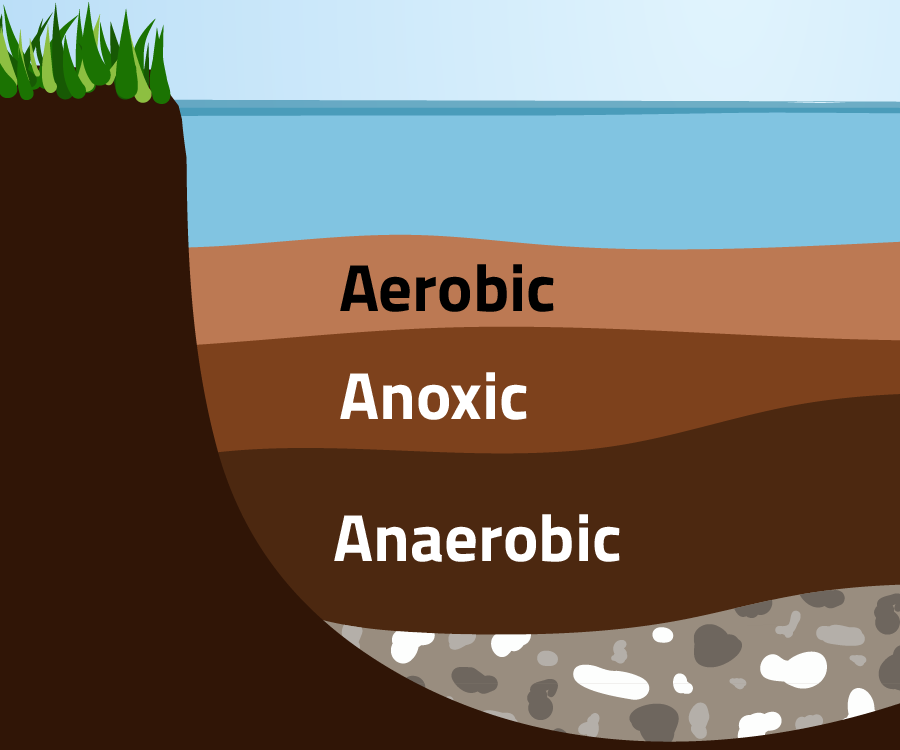Layers of Lagoon Sediment - Aquafix
Published on by Water Network Research, Official research team of The Water Network in Technology
Over time, wastewater lagoons accumulate sediment. This decreases the effective treatment volume, decreases hydraulic retention time (HRT), and can lower available oxygen in the water column. Suspended solids, organic matter, and microbial byproducts are constantly added and settle to the bottom of the lagoon. This begins with the deposition of heavier particles, such as sand and rocks, which settle quickly. Then, the lighter organic materials, such as decomposed plant matter, dead microorganisms, and sludge, accumulate in layers.
The uppermost sediment layer remains mostly oxygenated, supporting aerobic bacteria that break down organic matter. Under this is a facultative or anoxic layer that contains both aerobic and anaerobic or facultative anaerobic microorganisms that further decompose the organic matter. The deepest layer is the largest and anaerobic. This is where organic matter that’s hard to break down is slowly decomposed, producing gases such as methane and hydrogen sulfide. At the very bottom is a layer of inert inorganic matter such as sand or rocks. Depending on environmental factors and loading rates, sediment accumulation will vary, but eventually, a lagoon will require sediment removal to maintain operational efficiency.

Microorganisms in lagoon sediments break down organic waste at different depths. In the aerobic layer, aerobic bacteria use oxygen to decompose organic matter into simple compounds. This layer also includes small invertebrates such as insect larvae and worms that help to further aerate this layer and consume some organic matter. Fungi and protozoa are also involved in organic matter breakdown in this layer. In the facultative/anoxic layer, both aerobic and anaerobic microorganisms coexist and process organic matter through partial oxidation and fermentation. Facultative bacteria can utilize both oxygen and other electron acceptors such as nitrate. In the deepest anaerobic layer, there is no oxygen, and anaerobic bacteria use other electron acceptors to decompose organic matter through slow fermentation and methanogenesis. These anaerobic microbes release methane, hydrogen sulfide, and ammonia as by-products, contributing to sludge buildup. There are also reduced minerals such as ferrous (Fe2+), manganese, and phosphate released due to anaerobic metabolism that may move up or down the sediment layers depending on concentration gradients. With the continued accumulation of sludge, the anaerobic layer gets larger, and more gases, such as methane and hydrogen sulfide, are released into the upper layers and the water column. These gases react with dissolved oxygen and convert to carbon dioxide and water or sulfuric acid and water, which reduces overall dissolved oxygen in the water and sediments.

Microbial Metabolism
Adding aeration can increase dissolved oxygen in the water column and indirectly in the sediment layers. In shallow lagoons (6ft or less), it is common to see surface-only agitation such as paddle wheels being used. These types of aerators will agitate and mix the surface water, promoting oxygen exchange. In deeper waters, bottom diffusers or bubblers are more effective. These types of systems use compressors to pump oxygen to diffusers at the bottom of the lagoon. The rising bubbles mix the oxygen throughout the water column and physically reduce stratification. Sometimes, these systems may stir up sediment. Usually, this is enough to supply dissolved oxygen to the water column and sediment, however, other additives are required when events happen that quickly deplete the oxygen in the water column.
One additive to quickly oxygenate water is to inject liquid oxygen (LOX) into the water column. This is not commonly done due to cost and handling challenges. Other chemicals used include hydrogen peroxide, both liquid and granular forms, and sodium percarbonate. Hydrogen peroxide breaks down to water and oxygen in water and can quickly increase oxygen levels due to high organic matter loads, such as algae die-offs. Sodium percarbonate releases oxygen upon contact with water and can also oxidize some organic matter. Potassium permanganate is a stronger oxidizer that oxidizes organic matter, which indirectly improves dissolved oxygen levels. High concentrations may make the water a pink/purple color. Calcium peroxide can also be used to release oxygen slowly in deep water, although it may cause pH changes.
Mechanical and chemical supplementation of oxygen to a lagoon can keep the microbes in the water column and sediment functioning for a long time; however, eventually, the sediment will need to be removed since microbes cannot degrade the inorganic matter that accumulates.
Attached link
https://teamaquafix.com/lagoon-sediment-layers/?utm_source=WW+Contacts&utm_campaign=3d3ec0991e-EMAIL_CAMPAIGN_2025_Lagoon-Sediment-blog&utm_medium=email&utm_term=0_-85a2652311-450093074&mc_cid=3d3ec0991e&mc_eid=b56f312f14Taxonomy
- COD Removal
- Lagoon
- Biological Oxygen Demand (BOD)
- sedimentation
- Water, Waste Water Chemical & Treatment
- Domestic Water Use